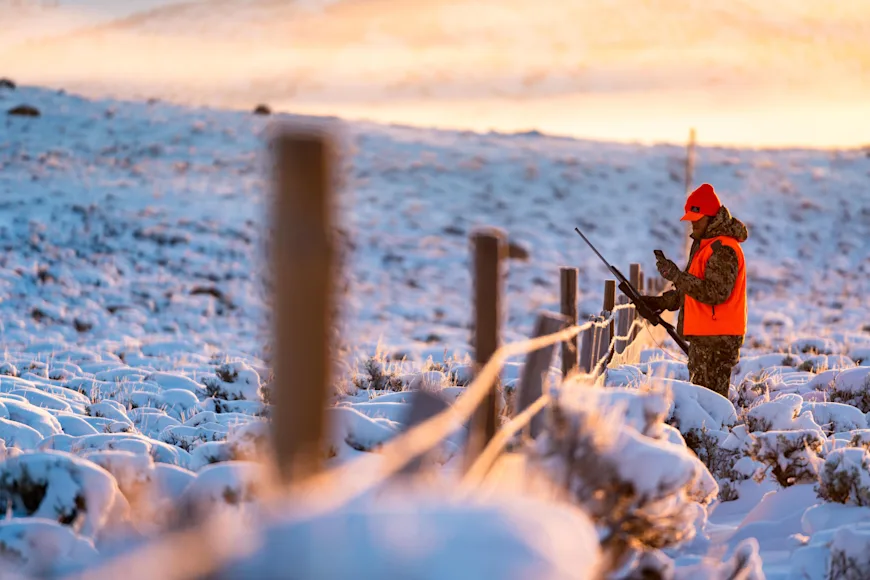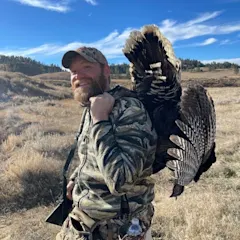There is a legacy of land ownership in the West that has left hunters locked out of large swaths of federally-owned public ground since before territories became states. These "checkerboarded" parcels of public land were carved up in the late 1800s, when the federal government handed out alternating 640-acre chunks to transcontinental railroad companies helping settle the West. With a monumental ruling in March 2025, the 10th Circuit Court of Appeals in Denver guaranteed hunters and other public land recreators a legally-protected right to access this land by crossing at the corners where two public parcels meet. The ruling opens millions of acres that were previously inaccessible across several Western states.
The 10th Circuit’s ruling put an exclamation point on a legal battle that began in southern Wyoming in 2022. That’s when four non-resident hunters from Missouri were prosecuted by landowner Fred Eshelman for using a ladder to corner cross between public parcels spread across his vast private holdings. They needed the ladder to scale a fence on a corner-locked portion of Eshelman’s 24,000-plus acre Iron Bar Ranch—which enclosed 27 federal parcels totaling 11,000 acres in Carbon County, Wyoming, the Colorado Sun reports.

The Case
By locking up corners, large landowners like Eshelmans have had exclusive access to checkerboarded public lands for many years. A North Carolina resident, Eshelman is an investor in the pharmaceutical industry, according to his website. He argued that the Missouri hunters violated the airspace above his ranch when they used the A-frame ladder to corner cross while hunting deer and elk more than five years ago.
"Those hunters were criminally prosecuted in Carbon County, and a jury acquitted them," Wyoming-based legal professor and Associate Vice President of the National Wildlife Federation David Willms tells Field & Stream. "Then the land owner decided to pursue them for a civil trespass and filed that in a federal district court."
When the federal district court determined that the hunters' actions didn't constitute civil trespass, Eshelman appealed to the 10th Circuit. "This 10th Circuit decision affirmed the federal district court decision, but with stronger language and stronger reasoning," says Willms. "They ruled that the Unlawful Inclosures Act preempts state law in this instance and grants an explicit right to legally access public lands."

The four Missouri hunters were supported in their legal battle by Backcountry Hunters & Anglers, which joined their lawsuit as a “friend of court” and raised over $200,000 to help with legal fees, BHA CEO Patrick Berry tells Field & Stream. “We consider this to be a historic and precedent-setting decision that finally allows Americans to access the lands they own,” Berry says. “When it comes to checkerboard parcels, you're looking at a huge amount of land that we all own but have not had the freedom to recreate on the way that we should."
Because the ruling invoked the federal "Unlawful Enclosures Act", individual states within the 10th Circuit's jurisdiction shouldn't have legal standing to pass laws against corner crossing. And while the decision leaves a lot of checkerboarded land in limbo, both Willms and Berry agree that the ruling could be persuasive in other districts that might take up future court cases around corner crossing the in the years to come.

Opening Millions of Acres to Their Rightful Owners
Berry says there are more than 8 million acres of checkerboarded lands across the West. “Credit for identifying and counting up the acreage of those parcels goes to OnX,” he said. “Their analysis shows that there are 8.3 million acres of corner-locked parcels all told, though this 10th Circuit ruling only applies to six states: Colorado, Wyoming, Utah, New Mexico, Kansas, and Oklahoma.”
Lisa Nichols is the Senior Philanthropy and Advocacy Manager for the digital mapping company OnX. She led the project that identified corner-locked parcels, which OnX released in April 2022 as the Corner Locked Report. “I dug into the history of corner crossing, worked with a member of our GIS staff on tuning the geospatial analysis, and conducted interviews,” Nichols says. “Then I drafted the story for our hunting audience and came up with the term ‘corner-locked’ to describe this specific subset of the landlocked public land.”

Nichols says she’d just begun the corner-locked project when news broke about the four hunters in Wyoming. “It was really wild timing," she recounts. "We already had the code to run our landlocked analyses, but we had to tweak it to find the parcels that were touching at corners. Then we took it a few steps further to find how many individual corners are involved (27,120), approximately how many unique private landowners share those corners (approximately 11,000), and how many corners would need to be crossed to reach the most remote parcel of corner-locked land (15 corners)."
From there, it was a matter of determining how best to connect the number-heavy information to the history of corner crossing, Nichols says. "We wanted to present it in a way that would be approachable to those that had never heard of the issue before," she says, "and provide new understanding to those who were quite familiar with it but didn't know the full scope across the West.”
Data from OnX's mapping app was analyzed by the courts during the Wyoming hunters' prolonged legal battle. They were subpoenaed to provide information, Nichols says, and that was followed up by a deposition—which was included in the court's final decision.

OnX's Advice on Corner Crossing
Now that scores of hunters will be using OnX to corner cross, the company has some tips on how to do it legally and ethically. One important point, according to Nichols, is that the ruling only applies to parcels in the 10th Circuit that are 100 percent corner-locked. "The ruling closely follows the specifics of the case in [Carbon County] Wyoming with the four Missouri elk hunters,” she said. “In that case, all other forms of access were restricted. If there's a road or a public trail or some other way to get into one of these parcels, then hunters should use those access points instead of corner crossing, in order to comply with the 10th Circuits Decision.”
Nichols says that OnX users should know that, while accurate, their mapping app cannot perfectly denote a hunter's precise location on the ground. "The hardware inside of a smartphone that connects to the GPS satellites, is only accurate to 16 feet," she points out. "If you're looking for an exact corner, you're talking about a very defined point on the surface of the earth. That's a game of inches, not feet."
Instead of relying on the blue dot that depicts your current location, hunters need to locate a physical survey marker before stepping over a corner, Nichols advises. "Often time the survey marker was put there by whatever federal land agency manages the land" she says. "But it could also be a marker from a county survey."

In certain scenarios, locating the survey marker can be tricky if not impossible. Some of them are nearly 100 years old, Nichols points out. And they're often buried beneath soil or obscured by vegetation. "If a hunter can't locate the marker, I would recommend contacting the local game warden or the agency that manages the land," she says. "Don't corner cross unless you have located the official survey marker."
Fences erected at corners create another legal grey area, OnX notes, because they might not sit on the precise property boundary. And touching a privately owned fence can constitute physical trespass, hence the large A-frame ladder used by the four Missouri elk hunters to scale Eshelman's fence in Carbon County, Wyoming.
Read Next: Congress Eyes Public Land Sell Off as Part of Special Budget Package
Nichols says OnX has identified at least 3 million acres of corner-locked land under 10th Circuit's jurisdiction, though the company didn't run an analysis on Oklahoma or Kansas. "That represents our findings in Colorado, Utah, New Mexico, and Wyoming," she says. "And the majority of those lands are in Wyoming, which has 2.4 million acres alone. We don't know how many of those corners are actually pinned out and monumented, but it's important for hunters to be ethical and exact when they go to corner cross in any of these 6 states."


